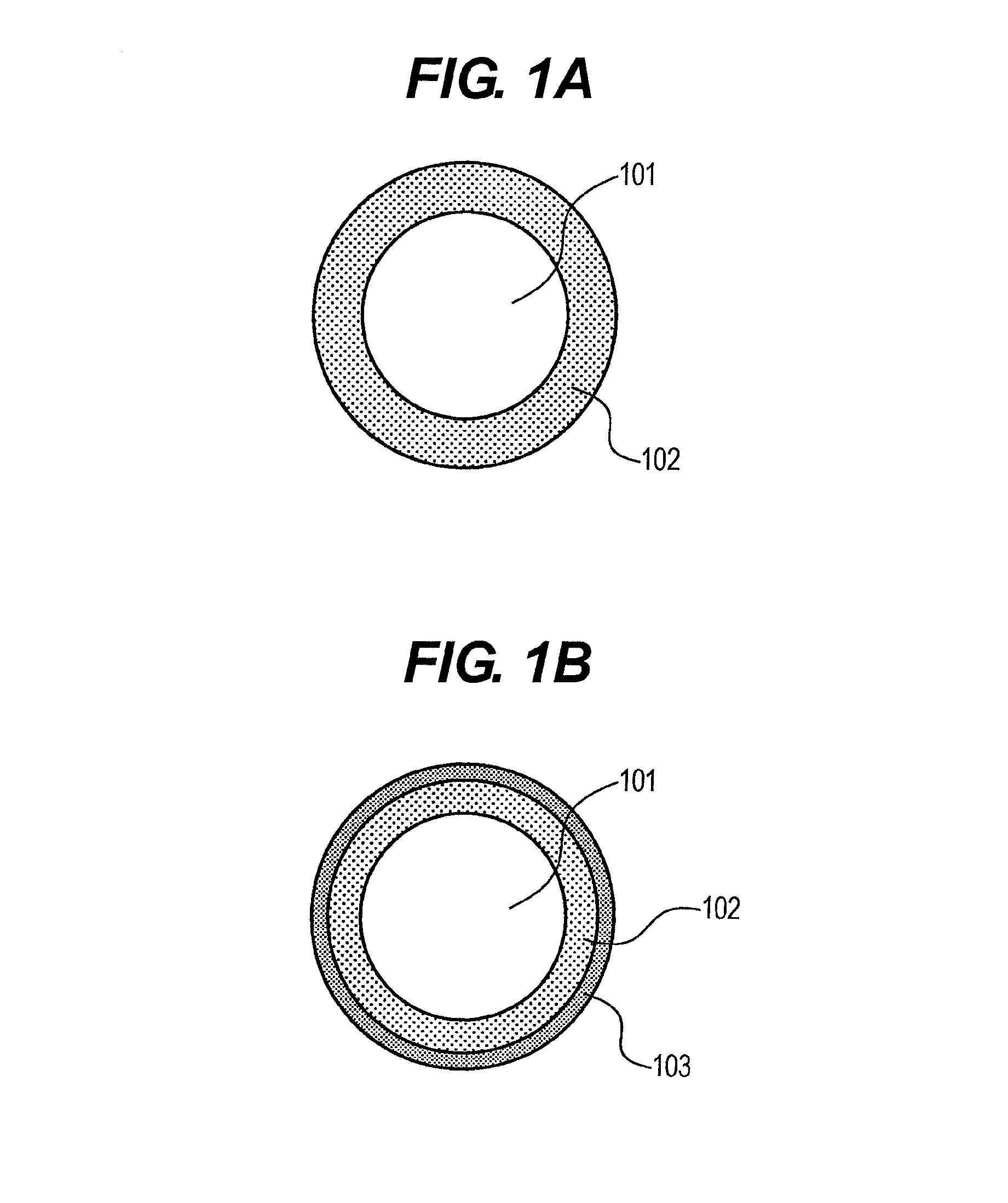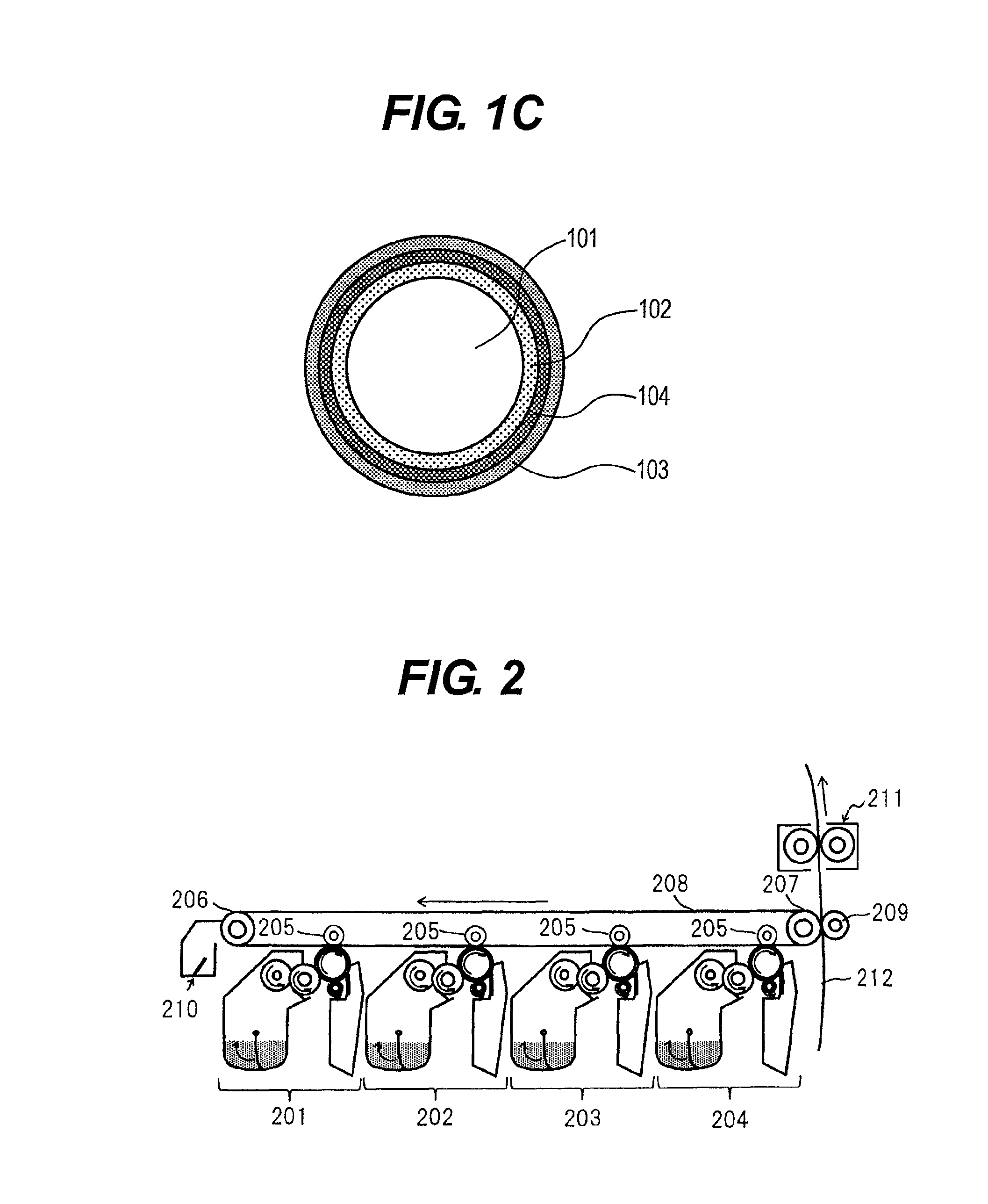Electrically conducting member, process cartridge, and electrophotographic apparatus
a technology of electrophotography and process cartridge, applied in the direction of conductors, instruments, corona discharge, etc., can solve the problems of variable electrical resistance, and achieve the effect of stably forming high-grade electrophotographic images
- Summary
- Abstract
- Description
- Claims
- Application Information
AI Technical Summary
Benefits of technology
Problems solved by technology
Method used
Image
Examples
synthesis example 1
Production of Polymer K:
The above polymer K was produced by the following procedure.
[0112]Preparation of Catalyst Solution
[0113]An autoclave of 1 liter in internal volume and with a stirrer was dried, and its inside was displaced with nitrogen. Into this autoclave, 52.9 g of tributylaluminum, 390 g of toluene and 98.8 g of diethyl ether were introduced, and then stirred while keeping the liquid temperature at 30° C. Further, with stirring continued, 7.8 g of orthophosphoric acid was slowly added to the mixture solution obtained. Subsequently, 4.0 g of triethylamine was added thereto. Thereafter, the mixture obtained was continued being stirred at 60° C. for 2 hours to obtain a catalyst solution.
[0114]Polymerization for Raw-material Polymer
[0115]An autoclave of 3 liters in internal volume and with a stirrer was dried, and its inside was displaced with nitrogen. Into this autoclave, 1,260 g of n-hexane and 43.9 g of the above catalyst solution were introduced, and then stirred while k...
synthesis examples 2 to 7
Production of Polymers L to Q:
Polymers L to Q were obtained in the same way as Synthesis Example 1 except that the types and amounts of the monomers 1 to 4 added were changed as shown in Table 3. The types A to E of the monomers as entered in Table 3 are shown in Table 4.
[0117]
TABLE 3Syn-thesisMono-Amt.Mono-Amt.Mono-Amt.Mono-Amt.Examplemer 1(g)mer 2(g)mer 3(g)mer 4(g)1A7.5A7.8B226.9C9.92D7.5D143.2B84.6C16.73E7.5E130B100.8C14.24D7.5D103.1B125.9C15.55E7.5E80.4B154C10.26D7.5D12.2B222.6C9.77D7.5D35.2B182.4C26.9
[0118]
TABLE 4MonomerMaterial nameAEthylene oxide (EO)BEpichlorohydrin (ECH)CAllyl glycidyl etherDPropylene oxide (PO)EButylene oxide (BO)
example 1
[0119]Production of Epichlorohydrin
[0120]Using the polymer A shown in Table 1 and the additive 1 shown in Table 2, epichlorohydrin was produced.
[0121]Stated specifically, 300 g of the polymer A was dissolved in 1,000 ml of N,N-dimethylformamide. Next, 1.5 g of the additive 1 was dissolved in 100 ml of ion-exchanged water. Then, the resultant aqueous solution of the additive 1 standing dissolved therein was mixed in the resultant N,N-dimethylformamide solution of the polymer A standing dissolved therein, followed by heating and stirring at 50° C. for 12 hours in an atmosphere of nitrogen. A solution of the reaction product obtained on completing the heating and stirring was concentrated to dryness by means of an evaporator to obtain a reaction product. The reaction product obtained was washed with ion-exchanged water to obtain an epichlorohydrin rubber 1.
[0122]Composition of the epichlorohydrin rubber 1 obtained was ascertained by proton NMR and carbon NMR. As the result, this epichl...
PUM
| Property | Measurement | Unit |
|---|---|---|
| thickness | aaaaa | aaaaa |
| volume resistivity | aaaaa | aaaaa |
| volume resistivity | aaaaa | aaaaa |
Abstract
Description
Claims
Application Information
 Login to View More
Login to View More - R&D
- Intellectual Property
- Life Sciences
- Materials
- Tech Scout
- Unparalleled Data Quality
- Higher Quality Content
- 60% Fewer Hallucinations
Browse by: Latest US Patents, China's latest patents, Technical Efficacy Thesaurus, Application Domain, Technology Topic, Popular Technical Reports.
© 2025 PatSnap. All rights reserved.Legal|Privacy policy|Modern Slavery Act Transparency Statement|Sitemap|About US| Contact US: help@patsnap.com



